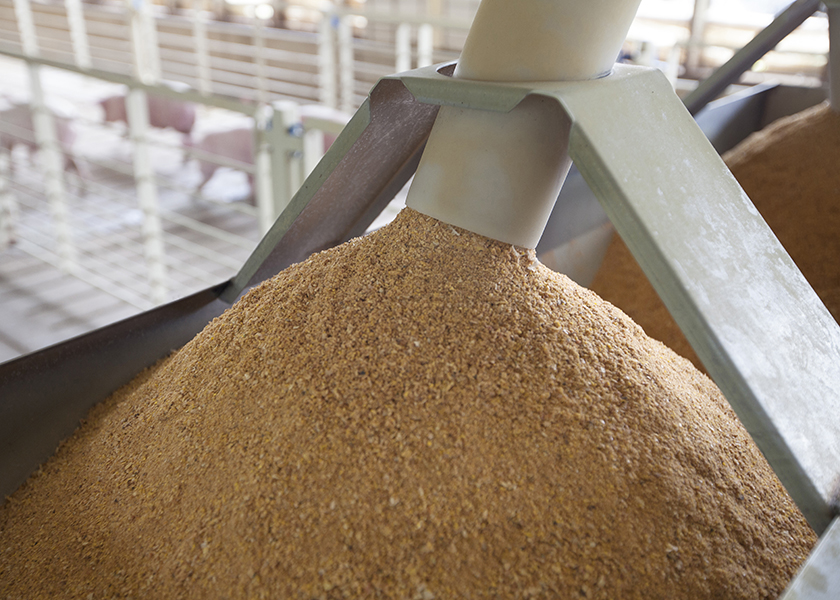By nature, biosecurity isn’t easy, Jordan Gebhardt, DVM, assistant professor in the Department of Diagnostic Medicine/Pathobiology at Kansas State University, said on a webinar on Nov. 5. And there’s a cost, too. Whether it’s reduced productivity and throughput because it takes a little more time to follow through extra steps or the actual cost of materials such as boot covers and disinfectant, biosecurity requires an investment.
But Gebhardt said it’s well worth the investment. With the constant threat of foreign animal diseases looming, the U.S. pork industry continues to look for ways to help keep disease out. In the last few years, research has exploded around the topic of biosecurity and feed and feed ingredients. More knowledge has become available about how viruses can be transferred in feed and feed ingredients, making biosecurity in a feed program more than a good idea.
“Biosecurity is the foundation of a successful feed safety program,” Gebhardt said in a webinar hosted by Kemin.
Producers need to understand where their ingredients come from and what biosecurity practices are being implemented during the manufacture, storage and delivery of those products, he said.
Why Does Biosecurity at the Feed Mill Matter?
Research shows feed ingredients can be contaminated with viruses. Although viruses naturally decay or lose infectivity over time, that rate of decay varies upon a number of conditions, including the storage time, temperature, humidity, as well as the environment into which that the that virus is inoculated or what the matrix that virus is inoculated into, Gebhardt explains.
If a pathogen survives in feed long enough, it can become problematic fast.
“Pigs can eat 20 or more times per day, representing multiple exposures per day,” he said. “And it’s been documented that increasing the number of exposures increases the infection probability.”
That’s why doing everything possible to enhance biosecurity at the feed mill is so critical. Gebhardt shares five ways to enhance biosecurity at the feed mill.
1. Extend biosecurity practices that have been widely adopted on swine farms.
We need to take those biosecurity practices on our swine farms and incorporate those into our feed mills, Gebhardt said.
“There are certainly approaches using foot baths either with wet chemical disinfection or dry disinfection that can help reduce the likelihood of pathogens entering the feed mill, but it’s our understanding that using a Danish-style entry bench where you completely switch shoes is the best approach to provide the greatest amount of risk reduction for pathogen introduction,” he said.
2. Use biosecurity visualization tools to train employees.
“As with any biosecurity practice, translating it into actual implementation within a facility can be a challenge,” he continued.
Employee training is key to a successful biosecurity program. For example, at the K-State swine farm, they found using a fluorescent powder such as GloGerm helped students understand the impact of a Danish-style entry bench on reducing the risk of contamination in the feed mill.
3. Control points of access.
Look for ways that contamination could occur and control those points of access. This could include areas where spillage can occur such as ingredient receiving pits as well as hand add locations, he said.
“Oftentimes, in order to prevent wastage, spillage is then recycled and simply swept into either the receiving pit or hand add location. Minimizing this to the greatest extent possible is the best approach to reduce the likelihood of any contamination present on your surfaces simply being swept into the feed supply system,” Gebhardt said.
4. Implement extreme measures such as feed transfer.
When K-State broke with porcine epidemic diarrhea virus (PEDV) approximately two years ago, they implemented a feed transfer protocol to prevent the spread of the virus to other farms that the mill served.
“We left one truck dedicated to that facility and then had one truck drive back and forth to the feed mill. The feed mill truck never entered onto the farm premises,” Gebhardt said. “This demonstrated that using such a procedure, while it may not be cost-effective, or logistically possible in all scenarios, can be successful at reducing the likelihood of contamination of that vehicle.”
Feed transfer protocol can be effective at reducing the likelihood that a feed truck that goes back to the feed mill can become contaminated and ultimately lead to the contamination of that mill, he said.
5. Disinfect vehicles inside and out.
It is commonly understood that the exterior surface and the interior cab surface of a vehicle can serve as a route of transferring disease such as PEDV or porcine reproductive and respiratory syndrome virus (PRRSV) from one location to another under certain conditions, Gebhardt said.
“More recently in a field investigation in Vietnam, we have documented that feed trucks and employee movement in and out of feed trucks can result in contamination of these surfaces with ASF virus,” he said.
Within a feed biosecurity program, he said it is important to consider the movement of people and trucks and consider methods to decontaminate these surfaces to reduce the potential for pathogen transmission.
“We always need to think about these concepts in biosecurity as a whole in an attempt to understand whether or not what we’re doing is sufficient to avoid infection in a population that is experiencing multiple potential exposures,” Gebhardt added.
He encourages producers to take every opportunity possible to reinforce biosecurity habits in the feed mill.
“If we’re walking through a mill and notice an employee that could change their habits a little bit to be more biosecure, it’s our job and our responsibility to continue to communicate the importance of that and continue to get better within what we do,” he said. “In short, biosecurity never stops.”
More from Farm Journal’s PORK:
Ultraviolet Light: Don’t Be Misled by a False Sense of Security


